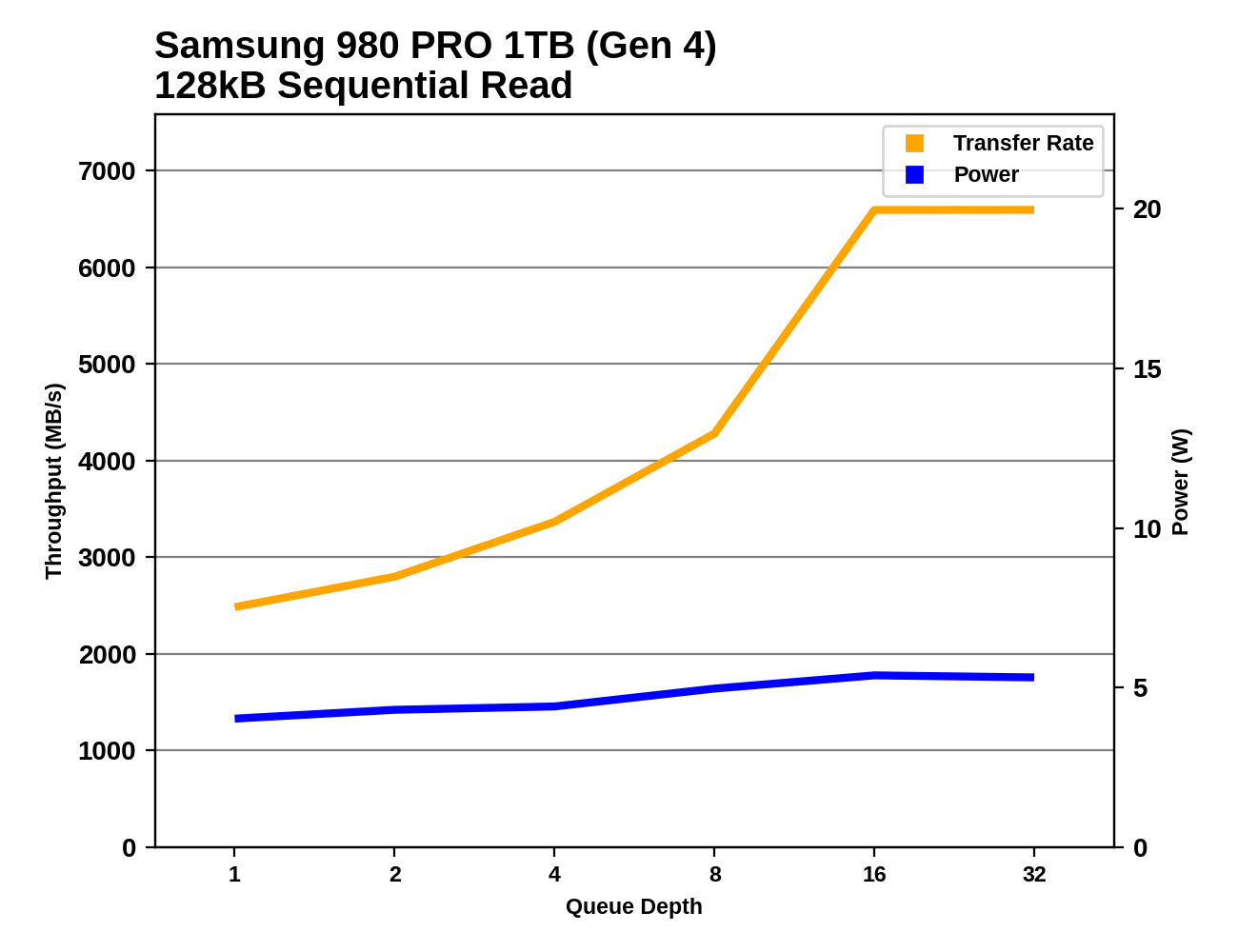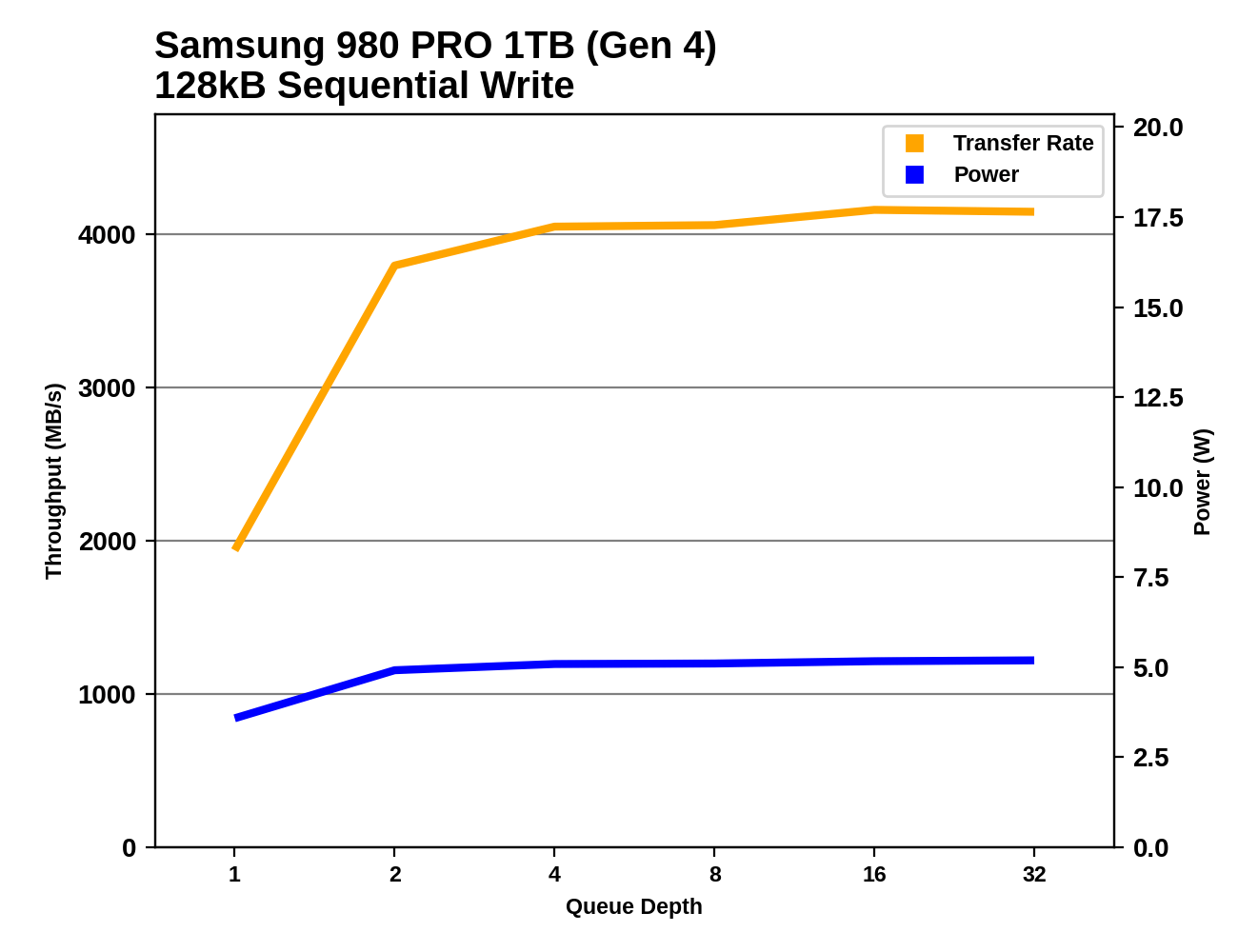The Samsung 980 PRO PCIe 4.0 SSD Review: A Spirit of Hope
by Billy Tallis on September 22, 2020 11:20 AM ESTNote: All our previous testing has been on an Intel test bed. Because of the move to PCIe 4.0, we have upgraded to Ryzen. Devices tested under Ryzen in time for this review are identified in the charts.
Sequential Read Performance
Our first test of sequential read performance uses short bursts of 128MB, issued as 128kB operations with no queuing. The test averages performance across eight bursts for a total of 1GB of data transferred from a drive containing 16GB of data. Between each burst the drive is given enough idle time to keep the overall duty cycle at 20%.

The burst sequential read performance of the Samsung 980 PRO is marginally faster than its predecessors, but the extra PCIe Gen4 bandwidth doesn't matter with a queue depth of just one. The drives using the SM2262EN controller stay on the top of this chart.
Our test of sustained sequential reads uses queue depths from 1 to 32, with the performance and power scores computed as the average of QD1, QD2 and QD4. Each queue depth is tested for up to one minute or 32GB transferred, from a drive containing 64GB of data. This test is run twice: once with the drive prepared by sequentially writing the test data, and again after the random write test has mixed things up, causing fragmentation inside the SSD that isn't visible to the OS. These two scores represent the two extremes of how the drive would perform under real-world usage, where wear leveling and modifications to some existing data will create some internal fragmentation that degrades performance, but usually not to the extent shown here.

On the longer sequential read test, the 980 PRO no longer has a clear advantage over its predecessors. The 250GB 980 PRO is slightly slower than the 970 EVO Plus even on our new testbed. The 1TB 980 PRO shows slight improvement in its performance reading back data that wasn't written sequentially, but the 970 PRO and the SK hynix Gold P31 are still significantly faster for that task.
 |
|||||||||
| Power Efficiency in MB/s/W | Average Power in W | ||||||||
The power efficiency scores for the 980 PRO on the sequential read test are a mixed bag. Overall, the scores are still good for a high-end NVMe drive, but it doesn't consistently improve over its predecessors, and when it does score better the improvement is small.
 |
|||||||||
The 980 PRO's sequential read performance doesn't saturate until around QD16: rather late in the test compared to most drives, but that's because high-end PCIe Gen3 drives have been hitting the host bandwidth limit at moderate queue depths. The 1TB 980 PRO does show decent performance scaling through the lower queue depths, taking it past the PCIe Gen3 limits by QD8. This is a clear improvement over the Phison E16-based Seagate FireCuda 520, which doesn't start gaining speed until after QD4.
The 250GB 980 PRO falters midway through the sequential read test, with performance dropping at QD4 and QD8, on both of our testbeds. At QD16 and higher it's still well above the PCIe Gen3 speed limit, but at lower queue depths it isn't an improvement over the 970 EVO Plus.
The sequential read performance of the 980 PRO—with sufficiently high queue depths—goes far beyond what's possible with PCIe Gen3, and the 1TB model stands out dramatically as significantly faster than even the Phison E16 drive. The E16 looks like an extrapolation of the high side of the general power/performance curve, but the 980 PRO blows past 6GB/s with power draw that would still be reasonable at half the speed.
Sequential Write Performance
Our test of sequential write burst performance is structured identically to the sequential read burst performance test save for the direction of the data transfer. Each burst writes 128MB as 128kB operations issued at QD1, for a total of 1GB of data written to a drive containing 16GB of data.

The burst sequential write speed scores for high-end NVMe drives have been fairly boring, with a narrow spread of scores for a wide variety of drives. The PCIe Gen4 drives break out of that rut and deliver real improvement to this QD1 performance, but the Phison E16-based Seagate FireCuda 520 is well ahead of the Samsung 980 PRO on this test.
Our test of sustained sequential writes is structured identically to our sustained sequential read test, save for the direction of the data transfers. Queue depths range from 1 to 32 and each queue depth is tested for up to one minute or 32GB, followed by up to one minute of idle time for the drive to cool off and perform garbage collection. The test is confined to a 64GB span of the drive.

On the longer sequential write test that includes low to moderate queue depths, the 980 PRO and the Phison E16 drive end up roughly tied, with the 980 PRO only 1% ahead overall. The smaller 250GB 980 PRO is a bit on the slow side compared to most of the 1TB drives, but it's several times faster than the 250GB 970 EVO Plus thanks to the larger SLC cache.
 |
|||||||||
| Power Efficiency in MB/s/W | Average Power in W | ||||||||
Since the 980 PROs are able to make good use of their high performance on this test, it's not too surprising that they post good efficiency scores for sequential writes. But even when tested on a PCIe Gen3 system the 980 PROs remain significantly more efficient than the 8-channel Gen3 drives, so the 980 PROs are also doing a good job of scaling down power consumption at lower speeds.
 |
|||||||||
At QD2 the 1TB 980 PRO's sequential write speed is already well above the practical limit for PCIe Gen3, but further increases in queue depth don't bring much more performance. The 980 PRO is generally a bit faster and more consistent than the Seagate FireCuda 520 on this test. The 250GB 980 PRO doesn't see any benefit from PCIe Gen4 execpt at QD1, because its SLC cache write speed doesn't come close to the PCIe Gen3 limit. Unlike the random write test, the 250GB 980 PRO makes it all the way through the sequential write test without running out of cache or experiencing a performance drop.
The two 1TB PCIe Gen4 drives extend the same power/performance trend set by most of the high-end Gen3 NVMe SSDs. The 980 PRO falls toward the more efficient side of that trend while the Phison E16-based Seagate drive is more power hungry and approaches the reasonable limits for M.2 drives.












137 Comments
View All Comments
Tomatotech - Tuesday, September 22, 2020 - link
NAND has a long way to go yet. It took a while for SATA SSDs to take off then they were bumping at the top of the SATA bandwidth for many years. Now the PCIe NVME drives are shooting up in data transfer speeds faster than the PCIe committee can bring out new speeds. NVME drives were all clustered at the top of PCIe 3.0 for a few years; PCIe 4.0 has only just come out and already much of the new headroom has gone. At this point the main bottlenecks are the drive controller chips and the PCIe standards themselves. 5.0 is being rushed out for a reason and it isn’t for GPU cards.MFinn3333 - Wednesday, September 23, 2020 - link
Modern SSD's endurance being small is mostly a myth. The last test I saw was on a Crucial BX500 120GB and it wrote 1.2PB on it before it gave out while a smaller 32GB hit around 250TB. The amount of voltage hitting the cells has dropped significantly over the years when they switched to Charged Trap Flash.The 600TBW is the minimum the drive will write.
Pinn - Tuesday, September 22, 2020 - link
Curious about cooling. It looks bare but not near a GPU? Did you see thermal throttling?Billy Tallis - Tuesday, September 22, 2020 - link
The most recent SMART log for the 1TB 980 PRO indicates that it has spent about two minutes at or above the warning temperature (82C) but hasn't hit the critical temperature (85C). And that's out of about 14 power-on hours of testing. The SMART logs for the 250GB drive indicate that it has not hit its warning temperature.back2future - Tuesday, September 22, 2020 - link
What's the cells endurance and storage data stability compared at DWPD=0.3 on these high temperatures (179F, 82C) with long term comparison? What to expect on 5 year professional (high throughput) usage patterns?Oxford Guy - Tuesday, September 22, 2020 - link
“Samsung is abandoning the use of the two bit per cell (MLC) memory that has been the hallmark of the PRO product lines, and with the 980 PRO, Samsung is finally switching to three bit per cell (TLC) NAND flash memory.Along with switching to TLC NAND, Samsung has cut the write endurance ratings in half to 0.3 DWPD and dropped the usable capacities down to the typical TLC/EVO levels of 250/500/1000 GB instead of 256/512/1024 GB. TLC means the 980 PRO now relies on SLC caching for its peak write speeds, and write performance will drop substantially if the SLC cache is ever filled.”
Finally!
What consumers hope for: Worse endurance and worse performance. Higher profits for the company selling it.
Notmyusualid - Tuesday, October 6, 2020 - link
@ Oxford - pretty much sums it up for me.Whiteknight2020 - Tuesday, September 22, 2020 - link
"Pro" means precisely and exactly, absolutely 0% of sod all. And always has. Either a product fits ones particular use case or it does not. I'm a "pro", in that I design, integrate an build Telco grade data centre systems deployments. I don't have a use for 600TBW to a 1TB drive, I'll never write that in it's useful life. I don't have a use for 6GB/s transfer rates. I do have a use for multiterabyte ssds at reasonable (1GB/s) transfer rates. For me, that would be a "pro" drive. For other workloads an entirely different "pro" profile is needed. There are few blanket use cases, except perhaps standard consumer laptop drives.Oxford Guy - Tuesday, September 22, 2020 - link
"'Pro' means precisely and exactly, absolutely 0% of sod all."You're correct and you're incorrect.
You're correct in the sense that Samsung has rendered "Pro" no longer compelling by selling inferior TLC NAND in this product, undermining the established reputation of its Pro-labeled product line.
You're incorrect in terms of this:
"And always has."
This is objectively flatly false. Samsung's Pro-labeled products have existed in the market for quite some time. They have an established reputation for targeting a specific level of performance and having other characteristics, like high-endurance MLC NAND.
Tomatotech - Wednesday, September 23, 2020 - link
See the StoragePro review. This drive has some fantastic numbers under enterprise workloads.For home use? I’m not so sure about the value there. There’s a reason it’s called Pro.
https://www.storagereview.com/review/samsung-980-p...